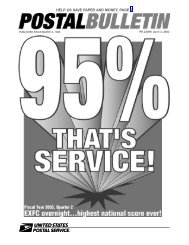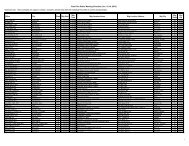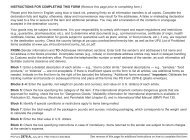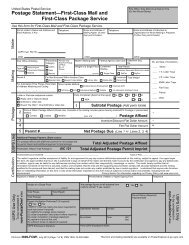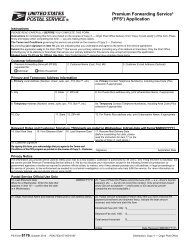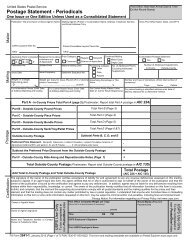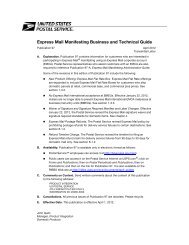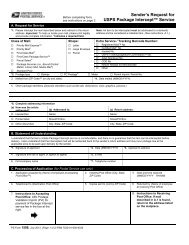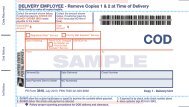Postal Bulletin 22144 - December 23, 2004 - USPS.com
Postal Bulletin 22144 - December 23, 2004 - USPS.com
Postal Bulletin 22144 - December 23, 2004 - USPS.com
You also want an ePaper? Increase the reach of your titles
YUMPU automatically turns print PDFs into web optimized ePapers that Google loves.
POSTAL BULLETIN <strong>22144</strong> (12-<strong>23</strong>-04)<br />
When towing containers, the PIT operator must use the<br />
brake levers to prevent jackknifing or loss of containers in<br />
the train.<br />
Folding Tow Bar<br />
67<br />
(See Handbook PO-502, Container Methods, for further information<br />
on proper use of mail equipment.)<br />
* * * * *<br />
Handbook EL-814, <strong>Postal</strong> Employee’s Guide<br />
to Safety<br />
* * * * *<br />
SECTION VIII<br />
Powered Industrial Trucks<br />
[Revise Section VIII to read as follows:]<br />
Powered industrial truck (PIT) operators are responsible for<br />
ensuring vehicle safety and following all safety requirements.<br />
Make sure that operators are trained and authorized<br />
to operate PITs described in OSHA 1910.178, such as tow<br />
motors, fork trucks, platform lift trucks, motorized hand<br />
trucks, and other specialized industrial trucks powered by<br />
electric motors or internal <strong>com</strong>bustion engines. All PIT-related<br />
accidents and near misses, including property damage,<br />
must be investigated and reported on a Form 1769.<br />
Fuel-powered industrial trucks are generally prohibited indoors.<br />
Consult with your local safety professional before<br />
using a fuel-powered industrial truck.<br />
A. Operating Rules<br />
1. General Rules<br />
Do not operate PITs in a reckless manner; this is<br />
strictly prohibited.<br />
Always wear your seat belt any time a PIT is in<br />
motion.<br />
Before using a PIT, check the brakes, steering<br />
apparatus, horn, etc. Report any defects to your<br />
supervisor immediately.<br />
Drive PITs at or below 5 miles per hour (about the<br />
speed of a fast walk). Use only the designated<br />
vehicle traffic lanes, and keep to the right when<br />
ever possible.<br />
Never use the reverse control as a brake.<br />
Never allow a passenger to ride on a PIT unless<br />
securely attached seating is provided. Never exceed<br />
the seating capacity of the unit.<br />
Never disengage, cover up, or bypass any audible<br />
or visual warning devices on powered industrial<br />
equipment.<br />
Do not ride with any part of your body protruding<br />
from the vehicle.<br />
Make sure that there is adequate clearance before<br />
you drive under any overhead obstruction.<br />
Approach all intersecting aisles and tow conveyor<br />
crossings slowly and cautiously. Sound your horn<br />
to warn pedestrians of your approach.<br />
Check to be sure there is a clear path to the rear<br />
before backing up.<br />
Stay at least three vehicle lengths behind other<br />
vehicles when traveling.<br />
Check bridge or dock plates for proper stability before<br />
you drive across them.<br />
Before dismounting, stop your vehicle, place the<br />
gear in neutral, set the brake, and turn the ignition<br />
off.<br />
2. Lift Trucks<br />
Lift, lower, and carry loads on a lift truck with the<br />
lifting mechanism in a vertical position or tilted<br />
back — never forward.<br />
Face the direction in which you are moving and be<br />
careful of rear-end swing when turning corners.<br />
When approaching or leaving a building where the<br />
ramp incline is greater than 10 degrees, turn the<br />
lift truck so the Ioad is on the upgrade side and<br />
cannot slip off the forks.



